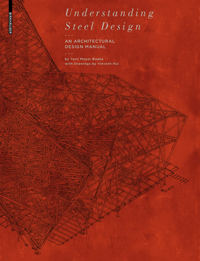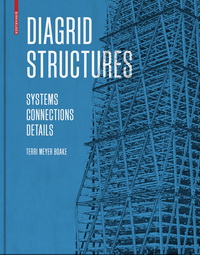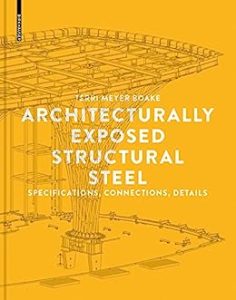Terri Meyer Boake
Birkhäuser

An Architectural Design Manual
Terri Meyer Boake
Birkhäuser, 2011
Diagrid Structures:
Systems, Connections, Details
Terri Meyer Boake
Birkhäuser, 2014
Architecturally Exposed Structural Steel:
Specifications, Connections, Details
Terri Meyer Boake
Birkhäuser, 2015
A recent series of books dedicated to the use of steel in design, Understanding Steel Design, Diagrid Structures, and Architecturally Exposed Structural Steel, by Terri Boake (University of Waterloo), underscore the currency of architectural designs that combine the tectonic expression of steel with particular attention to the craft of building craft and its detailing. The recent renaissance of building-technology-driven design and expression—reminiscent of the Industrial Revolution—is made possible by twenty-first-century emergent fabrication processes that allow architects a more direct and immediate participation in the creation and making of buildings. This return to the master-builder model is an extension of a broader cultural shift represented by do-it-yourself (DIY) and maker movements that encourage individual engagements with technology and personal empowerment by mastery of craft. This model offers architects the ability to pursue imaginative and innovative designs, assuming they are well versed in material and building technologies. The results are often highly creative projects that integrate all aspects of building design (tectonic, structural, and material construction) into a coherent and unified expression.
Terri Meyer Boake
Birkhäuser, 2011

Boake’s three books on the use of steel in design and construction reflect this particular positon and serve to introduce this new material technology to a broader audience. Its informative illustrations and thoughtful commentaries are of use to technology-minded design students and aspiring architects. The author documents and details innovative projects by a number of eminent architects and engineering firms, including Daniel Libeskind, Frank Gehry, Antoine Predock, Norman Foster, Richard Rogers, Renzo Piano, César Pelli, Peter Rice, and ARUP. Her selection of case studies effectively demonstrates the tectonic and expressive qualities of steel, a material that has continued to redefine architecture for the last two centuries. The work is historically situated, yet the book’s message is projective and inspiring; after all, the story of steel is far from complete, as a new generation of architects considers anew its applications and fabrication processes. The book is dedicated to “the state of tried-and-tested techniques” yet juxtaposes them with innovative projects that indicate more emergent conceptual trajectories in steel design. Questions of “how” and “why” permeate all three books and offer the reader an experienced understanding of how one creates and makes great architecture, in the appreciation of materiality, construction, and detailing.
Terri Meyer Boake
Birkhäuser, 2014

New Forms of Expression
A broader sensitivity for designing with steel is evident in the author’s discussion of the National Grand Theater of China in Beijing, designed by Paul Andreu. Boake demonstrates how an innovative approach to structural detailing using CNC processes and plasma cutting technologies allows for the production of highly customizable façade steel sections, without the need for what would in the past have been an extensive amount of steel bending. This new approach not only simplifies steel fabrication but also provides architects with greater design flexibility and a range of possible expressions. Boake’s focus on its multiple benefits—(1) lower costs, (2) enhanced design language, and (3) flexible fabrication—is noted in her claim: “The lesson in approaching curved steel design is simply to innovate. There are numerous ways to solve a problem—some more efficient, some more costly” (Understanding Steel Design, 123).
Terri Meyer Boake
Birkhäuser, 2015

Unified Design
In the case studies discussed in Architecturally Exposed Structural Steel, structural details—connections and members (with expressive shapes)—become primary contributors to an architectural design language that informs the building’s proportions, material selections, and component expressions. The sense of lightness and effortlessness associated with the featured projects further distinguishes the qualities of steel-based architecture in its sophisticated overlay of structural, constructional, and material expressions. The resultant synergy between pure structure and architectural expression forms a design continuum that permeates all architectural scales, from large tectonic gestures (as in the case of Diagrid Structures), to midsize elements (such as canopies), to the intimate scale of cable connections.
Having professional practice experience, as well as a passion for teaching building technology, this reviewer was particularly appreciative of the attention to construction assemblies and materiality evidenced in each book. Repeatedly, I have used these resources in the teaching of integrated structural systems and building envelope designs. Most valuable are the accompanying illustrations and the discussion of dynamic structural assemblies, including connections that accommodate building movements and load deflections (Understanding Steel Design, 187). Her featured assemblies provide interesting and inspiring ways to inform the overall design language of architecture. And the broad diversity of examples reinforces the vision of architecture informed by a genuine integration of design thinking with building systems and technical knowledge.
When discussing steel and timber framing systems, for example, Boake includes perspectives on material performance, connection design, and installation strategies, stating, “the detailing of hybrid structures must reconcile the differentiated movement of steel and wood due to temperature and moisture” (Understanding Steel Design, 205). This level of knowledge and discussion in a book that addresses both aesthetic and technical issues of steel design is not only impressive, but desirable. It effectively engages both performative and qualitative design considerations in a direct and easily understood manner.
Book Design and Illustration
Captivated and even seduced by the photographic essays, of which Boake is the photographer, each book moves beyond immediate impressions and provides the reader with thoughtful insights into the making and technical considerations attendant to each project. Her revealing close-up photography is further complemented by drawings and computer renderings of construction details and structural assemblies. What photography cannot communicate—the inner makeup of a detailed connection, component relationships, and spatial composition—a three-dimensional diagrammatic illustration can. (Illustrations in Understanding Steel Design were created by Vincent Hui of Ryerson University.) This combination of narrative and visual media effectively conveys the sophistication and complexities of steel-based designs.
Considering the Life Cycle
Beyond aesthetics, Understanding Steel Design discusses assemblies and disassemblies, adaptive reuse and the recyclability of steel construction. Topics related to the sustainability of steel, including a zero-waste fabrication approach, are emphasized in a number of case studies and in the final chapters. And relevant for architects, engineers, students, and educators is the recycle-versus-reuse discussion, which highlights important strategies for reducing material waste and building energy footprints when designing in steel. It demonstrates how architects can implement low-carbon solutions by considering the adaptive reuse of structural components, in a manner similar to how we have come to reuse timber. Boake concludes this discussion by highlighting how steel, and metals in general, has become the material of choice in many temporary structure designs given its modularity, cost-efficient assembly/disassembly, and ease of recyclability.
In conclusion, these three books on structural steel by Boake demonstrate how architecture can once again be a singular and seamless expression of form and structure through an effective integration of building technology with design and materiality. While they each emphasize strategies for steel design and detailing, they ultimately point to new directions in expressive and evocative forms of architecture that consider building performance and environmental impact alongside the intimate act of making found in buildings and architecture.
How to Cite this Article: Zarzycki, Andrzej. Review of Birkhäuser Steel Design Series, by Terri Meyer Boake. JAE Online. June 22, 2016. https://jaeonline.org/issue-article/birkh%c3%a4user-steel-design-series/.






